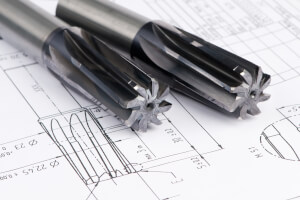Guide to End Mills: Application Types

The Complete Guide to End Mills: History, Applications, Types, and More
The Original Concept and History of the End Mill
The concept of the end mill can be traced back to the early 19th century, during the industrial revolution when advances in machinery and manufacturing processes were driving innovation. The first end mills were rudimentary tools, simple in design but effective for the milling processes of the time. These early tools were used primarily for simple cutting and shaping tasks on manual milling machines.
The modern end mill, as we know it today, began to take shape in the early 20th century with the advent of more complex machinery and the need for more precise cutting tools. The introduction of Computer Numerical Control (CNC) machines in the 1950s further advanced the design and application of end mills, enabling the creation of more intricate geometries and features with greater accuracy. Today, end mills are an essential tool in the manufacturing industry, used for a wide range of applications across various materials.
What is an End Mill?
An end mill is a type of milling cutter, a cutting tool used in industrial milling applications. It is distinguished from the drill bit in its application, geometry, and how it cuts materials. While a drill bit cuts in an axial direction, an end mill cuts in all directions, making it versatile for a variety of milling operations. End mills are used to remove material from a workpiece by advancing the tool into the material along its rotation axis.
End mills come in a variety of shapes, sizes, and types, each designed for specific tasks such as contouring, slotting, plunging, and profile milling. They are typically used on CNC machines but can also be used on manual milling machines.
Different End Mill Applications
End mills are used in numerous milling operations across various industries, including automotive, aerospace, electronics, and general manufacturing. Here are some common applications:
- Slotting: Cutting slots into a workpiece is a common application for end mills. The tool can be used to create precise slots of varying depths and widths.
- Profiling: End mills are often used to cut complex shapes and profiles into materials, including contours and intricate designs.
- Plunging: Although drilling is typically done with a drill bit, end mills can be used for plunging operations, where the tool cuts directly into the material along its axis.
- Face Milling: End mills can be used for face milling operations, where the tool is used to produce flat surfaces on the workpiece.
- Engraving: Small end mills are often used for engraving applications, where fine details are needed on the surface of a material.
- Finishing: End mills are also used for finishing operations, where the final surface finish and dimensional accuracy are critical.
Different Sizes of End Mills and Their Usages
End mills come in a wide range of sizes, each suited to specific tasks and materials:
- Micro End Mills (0.1mm to 2mm):
Usage: These are used for extremely fine detailing, precision machining, and engraving in applications like electronics, medical devices, and small-scale prototyping. - Small End Mills (2mm to 6mm):
Usage: Ideal for detailed work, including slotting and profiling in small parts manufacturing, such as in the jewelry and electronics industries. - Standard End Mills (6mm to 20mm):
Usage: These are the most commonly used end mills, suitable for a wide range of general-purpose milling tasks in industries like automotive and aerospace. - Large End Mills (20mm and above):
Usage: Used for heavy-duty operations like roughing, where large amounts of material need to be removed quickly, such as in the construction and shipbuilding industries.
Best End Mill Makers
Several companies are recognized as leaders in the manufacturing of high-quality end mills. Here are some of the top makers:
- Kennametal:
Known for their durable and reliable end mills, Kennametal offers a wide range of products suitable for various materials and applications. - Seco Tools:
Seco Tools is renowned for its innovative designs and high-performance end mills, particularly in the aerospace and automotive industries. - Sandvik Coromant:
A global leader in cutting tools, Sandvik Coromant provides end mills that are highly regarded for their precision and efficiency. - OSG Corporation:
OSG offers an extensive lineup of end mills, including specialized tools for difficult-to-machine materials like titanium and Inconel. - Walter AG:
Walter AG is known for its advanced coatings and materials, producing end mills that deliver exceptional wear resistance and longevity.
What is an End Mill Made Of?
End mills are typically made from one of the following materials:
- High-Speed Steel (HSS):
Pros: HSS end mills are relatively inexpensive and offer good toughness, making them suitable for general-purpose milling.
Cons: They wear out faster than other materials and are not ideal for high-speed or high-precision applications. - Cobalt Steel:
Pros: Cobalt end mills are more heat-resistant than HSS, allowing for higher cutting speeds and longer tool life.
Cons: They are more brittle than HSS, which can lead to chipping if not used properly. - Carbide:
Pros: Carbide end mills are known for their hardness, heat resistance, and ability to maintain a sharp cutting edge, making them ideal for high-speed and precision milling.
Cons: They are more expensive and can be brittle, requiring careful handling. - Ceramic:
Pros: Ceramic end mills are incredibly hard and can handle very high temperatures, making them suitable for cutting hard materials like hardened steels and superalloys.
Cons: They are very brittle and can easily break if not used correctly. - Diamond Coated:
Pros: These end mills are coated with a layer of diamond particles, providing extreme wear resistance and longevity, especially in abrasive materials like graphite and composites.
Cons: They are the most expensive and are typically reserved for specialized applications.
Multiple Types of End Mills: Pros and Cons
There are several types of end mills, each designed for specific tasks:
- Square End Mills:
Pros: Versatile and can be used for a variety of operations, including slotting, profiling, and face milling.
Cons: May not provide the best finish in all applications. - Ball Nose End Mills:
Pros: Ideal for contouring and 3D modeling, as they can produce smooth finishes on complex surfaces.
Cons: Not suitable for flat surfaces and can be more expensive. - Corner Radius End Mills:
Pros: Combine the versatility of square end mills with added strength, reducing chipping at the corners.
Cons: More specialized, so may not be as useful in general-purpose milling. - Tapered End Mills:
Pros: Excellent for machining angled surfaces and cavities, commonly used in mold making.
Cons: Limited to specific applications, making them less versatile. - Roughing End Mills:
Pros: Designed for heavy material removal with a wavy cutting edge that reduces cutting forces.
Cons: Produce a rough surface finish and are typically used for initial roughing operations. - Finishing End Mills:
Pros: Provide a smooth surface finish, ideal for final passes in precision machining.
Cons: Not designed for heavy material removal, so they are typically used after roughing operations.
Conclusion
End mills are a crucial component in the manufacturing industry, offering versatility and precision across a wide range of applications. Understanding the history, types, materials, and uses of end mills can help manufacturers and machinists choose the right tool for their specific needs, improving efficiency and product quality. As technology continues to evolve, so too will the design and capabilities of end mills, ensuring they remain an indispensable tool in modern machining.


